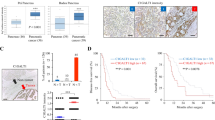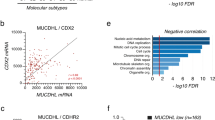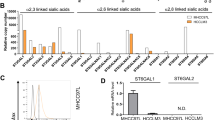Abstract
Changes in carbohydrates on the cell surface are associated with tumor malignancy. The mucin-type core 2 β-1,6-N-acetylglucosaminyltransferase (C2GnT-M) is highly expressed in the gastrointestinal tract and catalyses the formation of core 2, core 4, and blood group I branches on O-glycans. In the present study, we evaluated the role of C2GnT-M in colorectal cancer. C2GnT-M downexpression was observed in 73.6% of the primary tumors from colorectal cancer patients (39 of 53) analysed by cancer profiling array. Consistently, the majority of colon cancer cell lines and primary colon tumors expressed lower levels of C2GnT-M than did normal colon tissues by RT–PCR. HCT116 cells stably transfected with C2GnT-M inhibited expression of the core 1 structure, Galβ1,3GalNAcα1-Ser/Thr, on the cell surface. Moreover, C2GnT-M expression suppressed cell adhesion, motility, and invasion as well as colony formation ability. The growth of C2GnT-M-transfected HCT116 and SW480 cells was dramatically suppressed, and the cell death induced by C2GnT-M was demonstrated by an increase in the annexin V-positive cells. Interestingly, C2GnT-M inhibited cell adhesion to collagen IV and fibronectin, and decreased tyrosine phosphorylation of paxillin, indicating that the changes in cancer behavior may be partly mediated by integrin-signaling pathways. Tumor growth in vivo was also significantly suppressed by C2GnT-M in the xenografts of nude mice. These results demonstrate that C2GnT-M is frequently downregulated in colorectal cancer and suppresses colon cancer cell growth.
This is a preview of subscription content, access via your institution
Access options
Subscribe to this journal
Receive 50 print issues and online access
$259.00 per year
only $5.18 per issue
Buy this article
- Purchase on Springer Link
- Instant access to full article PDF
Prices may be subject to local taxes which are calculated during checkout








Similar content being viewed by others
Abbreviations
- RT–PCR:
-
reverse –transcription–polymerase chain reaction
- C2GnT:
-
core 2 β-1,6-N-acetylglucosaminyltransferase
- C4GnT:
-
core 4 β-1,6-N-acetylglucosaminyltransferase
- FAK:
-
focal adhesion kinase
- ST6GalNAc I:
-
CMP, sialic acid:Gal β1,3GalNAc-R α6-sialyltransferase I
References
Baldus SE, Zirbes TK, Hanisch FG, Kunze D, Shafizadeh ST, Nolden S et al. (2000). Cancer 88: 1536–1543.
Bierhuizen MF, Fukuda M . (1992). Proc Natl Acad Sci USA 89: 9326–9330.
Bowden ET, Barth M, Thomas D, Glazer RI, Mueller SC . (1999). Oncogene 18: 4440–4449.
Brockhausen I . (1999). Biochim Biophys Acta 1473: 67–95.
Brockhausen I, Yang J, Dickinson N, Ogata S, Itzkowitz SH . (1998). Glycoconj J 15: 595–603.
Burridge K, Turner CE, Romer LH . (1992). J Cell Biol 119: 893–903.
Cao Y, Karsten UR, Liebrich W, Haensch W, Springer GF, Schlag PM . (1995). Cancer 76: 1700–1708.
Clement M, Rocher J, Loirand G, Le Pendu J . (2004). J Cell Sci 117: 5059–5069.
Duncan G, McCormick C, Tufaro F . (2001). J Clin Invest 108: 511–516.
Fukuda M . (1996). Cancer Res 56: 2237–2244.
Guo W, Giancotti FG . (2004). Nat Rev Mol Cell Biol 5: 816–826.
Hakomori S . (2002). Proc Natl Acad Sci USA 99: 10231–10233.
Hanisch FG, Baldus SE . (1997). Histol Histopathol 12: 263–281.
Hollingsworth MA, Swanson BJ . (2004). Nat Rev Cancer 4: 45–60.
Huang MC, Laskowska A, Vestweber D, Wild MK . (2002). J Biol Chem 277: 47786–47795.
Hynes RO . (2002). Cell 110: 673–687.
Inaba Y, Ohyama C, Kato T, Satoh M, Saito H, Hagisawa S et al. (2003). Int J Cancer 107: 949–957.
Iwai T, Kudo T, Kawamoto R, Kubota T, Togayachi A, Hiruma T et al. (2005). Proc Natl Acad Sci USA 102: 4572–4577.
Khaldoyanidi SK, Glinsky VV, Sikora L, Glinskii AB, Mossine VV, Quinn TP et al. (2003). J Biol Chem 278: 4127–4134.
Lamorte L, Rodrigues S, Sangwan V, Turner CE, Park M . (2003). Mol Biol Cell 14: 2818–2831.
Liotta LA, Stetler-Stevenson WG . (1991). Cancer Res 51: 5054s–5059s.
Ovadia H, Hanna N, Nelken D . (1975). Eur J Cancer 11: 413–417.
Petit V, Boyer B, Lentz D, Turner CE, Thiery JP, Valles AM . (2000). J Cell Biol 148: 957–970.
Quattrocchi CC, Wannenes F, Persico AM, Ciafre SA, D’Arcangelo G, Farace MG et al. (2002). J Biol Chem 277: 303–309.
Schneider F, Kemmner W, Haensch W, Franke G, Gretschel S, Karsten U et al. (2001). Cancer Res 61: 4605–4611.
Schwientek T, Nomoto M, Levery SB, Merkx G, van Kessel AG, Bennett EP et al. (1999). J Biol Chem 274: 4504–4512.
Schwientek T, Yeh JC, Levery SB, Keck B, Merkx G, van Kessel AG et al. (2000). J Biol Chem 275: 11106–11113.
Shimodaira K, Nakayama J, Nakamura N, Hasebe O, Katsuyama T, Fukuda M . (1997). Cancer Res 57: 5201–5206.
Springer GF . (1984). Science 224: 1198–1206.
Springer GF . (1997). J Mol Med 75: 594–602.
Steiner MS, Zhang X, Wang Y, Lu Y . (2000). Cancer Res 60: 4419–4425.
Tsubouchi A, Sakakura J, Yagi R, Mazaki Y, Schaefer E, Yano H et al. (2002). J Cell Biol 159: 673–683.
Turner CE, Glenney Jr JR, Burridge K . (1990). J Cell Biol 111: 1059–1068.
Vavasseur F, Dole K, Yang J, Matta KL, Myerscough N, Corfield A et al. (1994). Eur J Biochem 222: 415–424.
Vavasseur F, Yang JM, Dole K, Paulsen H, Brockhausen I . (1995). Glycobiology 5: 351–357.
Xia L, Ju T, Westmuckett A, An G, Ivanciu L, McDaniel JM et al. (2004). J Cell Biol 164: 451–459.
Yang JM, Byrd JC, Siddiki BB, Chung YS, Okuno M, Sowa M et al. (1994). Glycobiology 4: 873–884.
Yeh JC, Ong E, Fukuda M . (1999). J Biol Chem 274: 3215–3221.
Acknowledgements
We thank Dr Fang-Jen S Lee for cancer profiling array analysis, Drs Tsai-Kun Li and Shu-Chun Teng for support and help, Dr Tzuu-Shuh Jou for anti-myc mAb, Dr Jih-Hwa Guh for HT29 cell line, Dr Shyh-Chyi Lo for anti-I polyclonal antibody, and Ru-Ying Tsai for technical assistance. This study was supported by National Health Research Institute Grant NHRI-EX94-9410BC; National Science Council Grants NSC 92-2321-B-002-024 and NSC93-2320-B-002-126, and National Taiwan University Hospital Grants NTUH.92A16, NTUH.93A03 and NTUH.094M13.
Author information
Authors and Affiliations
Corresponding author
Rights and permissions
About this article
Cite this article
Huang, MC., Chen, HY., Huang, HC. et al. C2GnT-M is downregulated in colorectal cancer and its re-expression causes growth inhibition of colon cancer cells. Oncogene 25, 3267–3276 (2006). https://doi.org/10.1038/sj.onc.1209350
Received:
Revised:
Accepted:
Published:
Issue Date:
DOI: https://doi.org/10.1038/sj.onc.1209350
Keywords
This article is cited by
-
The role of GCNT1 mediated O-glycosylation in aggressive prostate cancer
Scientific Reports (2023)
-
Glycosyltransferases as targets for therapeutic intervention in cancer and inflammation: molecular modeling insights
Chemical Papers (2022)
-
The role of glycosyltransferase enzyme GCNT3 in colon and ovarian cancer prognosis and chemoresistance
Scientific Reports (2018)
-
Colonic carcinogenesis along different genetic routes: glycophenotyping of tumor cases separated by microsatellite instability/stability
Histochemistry and Cell Biology (2012)
-
Expression of tissue inhibitor of metalloproteinases-3 messenger RNA and protein in porcine endometrium during implantation
Molecular Biology Reports (2011)



